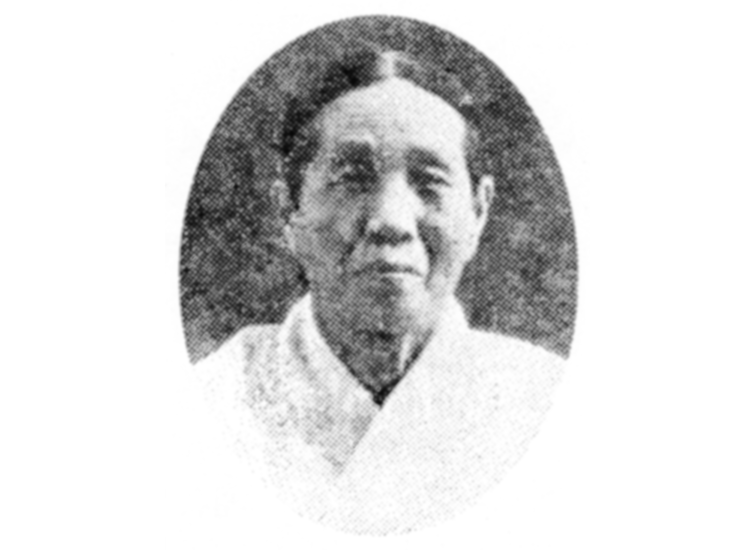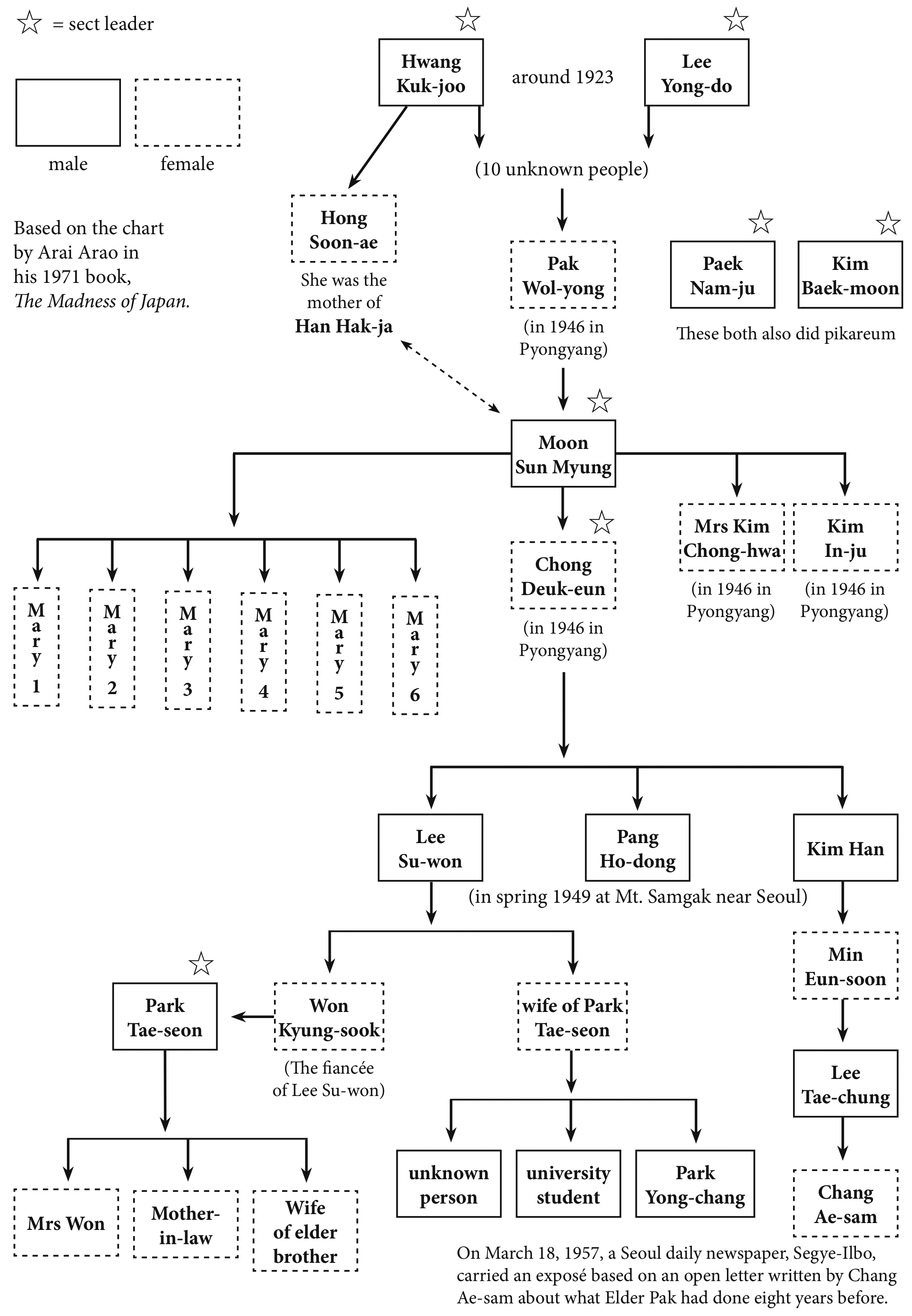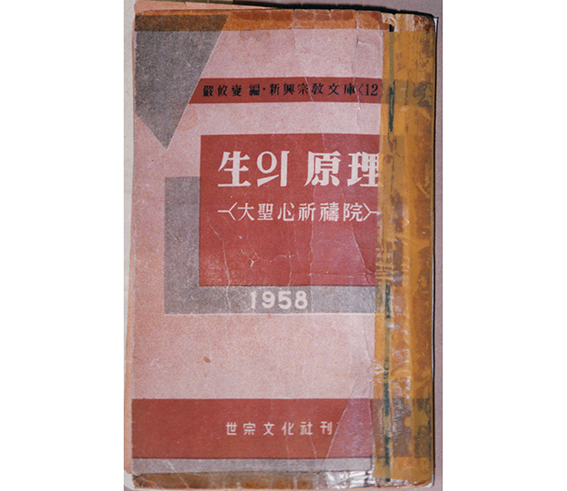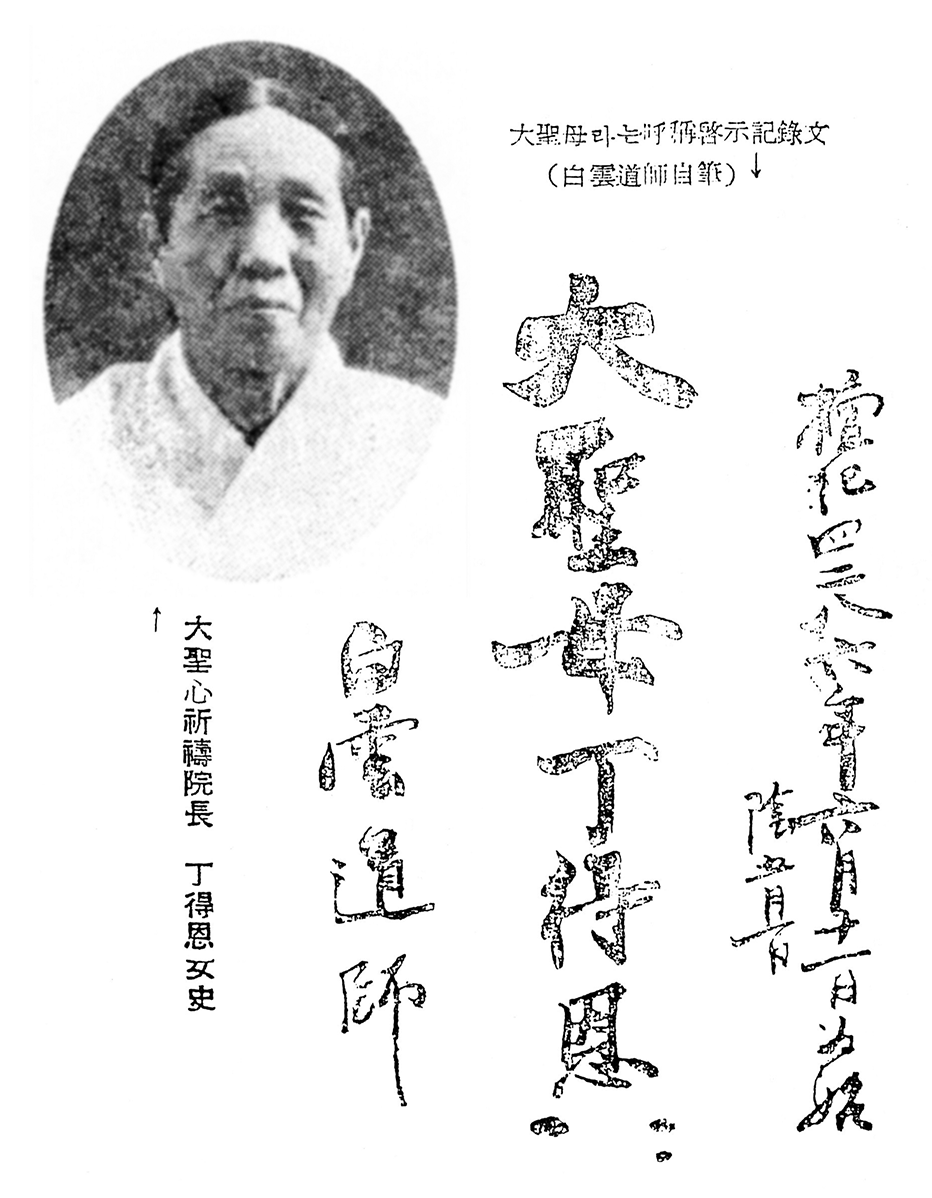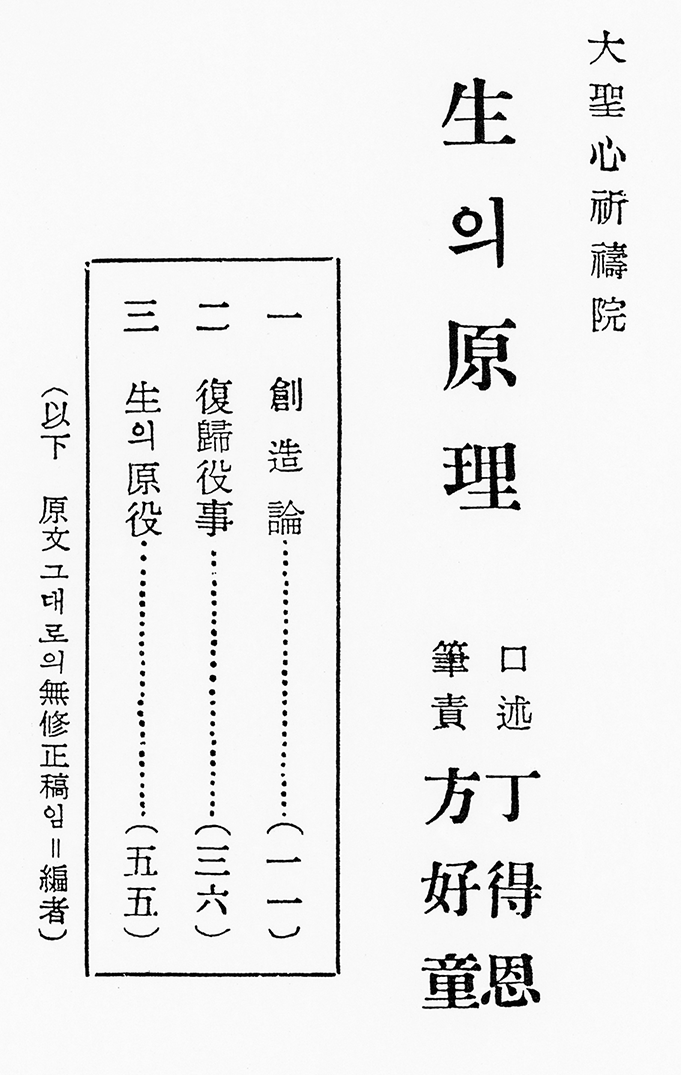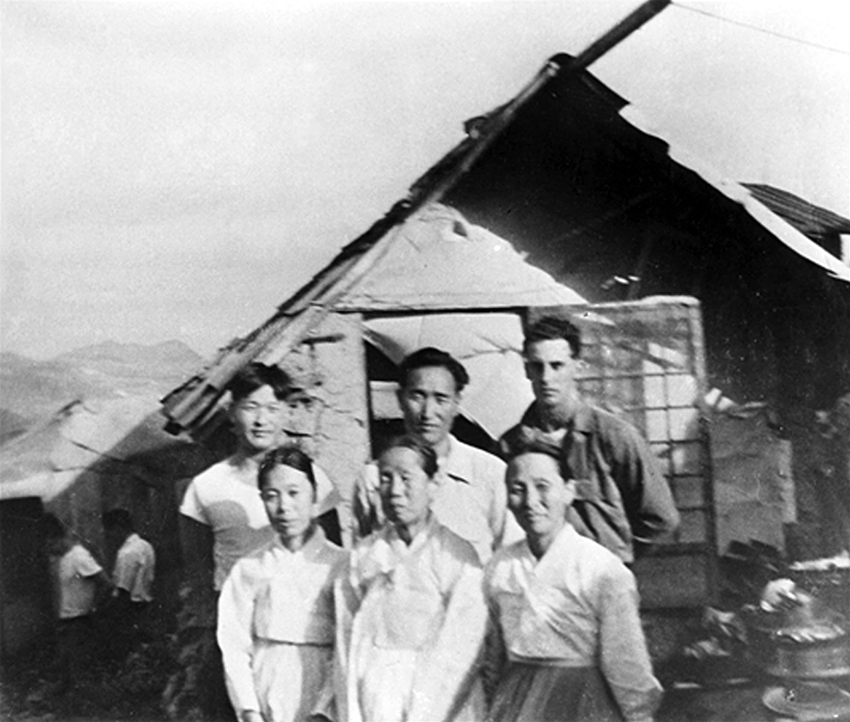
▲ Back row from left: Kim Won-pil, Moon and Clayton O. Wadsworth (a pastor with the US army in Busan).
Front row: unknown, 丁得恩 (or 鄭得恩) Chong Deuk-eun, and in front of Wadsworth is 季奇完 Lee Kee-hwan.
The photo was taken on Pomnekkol in Busan in the summer of 1951 by Park Kyung-do. Park had met Moon in about 1938 when Moon lodged at his parents’ house in Heukseok-dong, just south of the Han River in Seoul. Park was a student in Moon’s Sunday School class at the Jesus Church in Myungsudae. Park joined Kim Baek-moon’s Israel Monastery, and was with Kim in Busan. Kim had moved south because of the Korean war. Park then left Kim to join Moon. Park said: “If I had attended the church I could have been blessed among the 36 couples, but because I did not attend regularly I was not able to join in.”
She was also known as Jung Deuk-eun, Cheong, Chung, Chong Tuk-un (by Kirsti Nevalainen) and Chong Dok Young. There are a couple of other minor variations of her name. The Chinese characters of her name can be written in the roman alphabet (romaja) in different ways.
Her followers called her “DaeSeongMo” 대성모 “Great Holy Mother” 大聖母.
Kirsti L. Nevalainen wrote a book, Change of Blood Lineage through Ritual Sex in the Unification Church (ISBN 978-1439261538). On page 64 she explained that in 1946 Chong Deuk-eun began to attend a church in the Pyongyang area named Kwang-ya Kyohoe. In this church she met Pak Wol-yong (the “wife of Jehovah”) and Sun Myung Moon. Nevalainen describes the relationship between Chong and Moon extensively in chapter three of her book.
Chong Deuk-eun is listed as a “Unificationist in North Korea” on page 188 of Michael Breen’s book, Sun Myung Moon, the early years 1920-1953. It is notable that she is only mentioned in passing in his book. She was a very significant person in the story of Moon – as were several others who Breen omitted.
Chong is identified in the top photo in the Sabo magazine (no. 36), an early Unification Church / FFWPU publication. She can also be recognized from the photo in her own book, which was called The Principle of Life. Ms Chong had dictated her teachings to a faithful follower, Pang Ho-dong, in 1947 at Mt. Samgak which is just north of Seoul where she had established a prayer house. The 93 page book was edited by Om Yu-sop and published on July 5, 1958, shortly after she died. He added an introduction to the book, but her notes were faithfully reproduced.
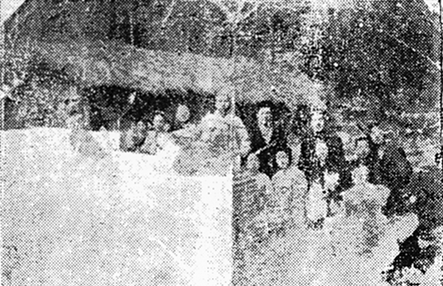 ▲ Chong Deuk-eun and Pang Ho-dong at the Mt. Samgak Prayer House in 1947.
▲ Chong Deuk-eun and Pang Ho-dong at the Mt. Samgak Prayer House in 1947.
Moon took many ideas from her theology, which he became familiar with during the time they worked together—from June 1946 to early 1947—before she moved from Pyongyang to near Seoul.
Later, copies of her notes were available to Moon and to Hyo-won Eu who wrote the 1957 Divine Principle.
Lee Yo-han had been Chong’s assistant pastor! He left her to join Moon in 1953 in Busan. Lee could explain her theology in detail. Chong and Moon were both pikareum messiahs. (see below for further information about Lee Yo-han.)
Rev Yong Jin-Hun, the FFWPU lecturer, has helped to link both Chong Deuk-eun, and Moon’s second ‘wife’, Kim Chong-hwa, to Moon. Yong wrote: “Members who were spiritually led: Chung Deuk-eun, Kim Jong-hwa, Chung Myeong-seon, etc.” on slide No. 8 from his “Course for Relaunching Providence” presentation. (Chung Myeong-seon was the husband of Kim Jong-hwa / Chong-hwa.)
http://www.tparents.org/Library/Unification/Talks/Yong/Yong-110200c.pdf
Kim Chong-hwa was Moon’s second ‘wife’ until they were both arrested in Pyongyang on February 22, 1948 when he was conducting “The Marriage Supper of the Lamb” with her. It is on the record that Moon and Kim were both jailed for bigamy. She spent a year in prison in Pyongyang before rejoining her husband, who had moved to Seoul. She was very grateful to him for accepting her back. She never wanted to see Moon again, although Moon sent Pak Chung-hwa to visit her seven times in Seoul after the war. LINK
Chong Deuk-eun had been a disciple of Hwang Kuk-ju who was famous for his ‘orgies’. Researchers into Korean pikareum generally come to the conclusion that he was the man who started this pseudo-Christian sexual intercourse ritual in Korea. There is information about Hwang Kuk-ju here: LINK
There is also this reference in Rev Yoo Joseph Chang-Hyung’s A Reformed Doctrine of Sanctification for the Korean Context (Ph.D. thesis submitted to the Faculty of Theology, University of Pretoria, South Africa.) February 2007. Page 423: “Cf. Dong-Ju Lee, “Why do we call the Unification [Church] a Heresy?,” Ministry and Theology no. 70 (April, 1995), p.209. In 1957 Dr Sa-Hun Shin disclosed the lineage of a circle of Pigarm [pikareum]. Moon’s Pigarm was traced to Deuk-Eun Jung [Chong], who was a disciple of Kuk-Ju Hwang. Ibid, p. 208.”
Chong Deuk-eun worked with Moon in Pyongyang during an 8-month period. They forged some sort of relationship, enough for her to want to visit him in Busan three times in 1952. ‘Follower of Moon’ is not the best description for her. Unification Church historians tend to describe many people as ‘members of the UC’ or ‘followers of Moon’.
Chong Deuk-eun had built a following of her own at Mt. Samgak from 1947, as seen in the above photo.
During the Korean War, she became a refugee moving around, and often she so exactly predicted which place was to be bombed, and at what time, that many people were suspicious of her. After the war she established a Prayer House and an orphanage.
In 1991 Ryo Hagiwara published The Life of Sun Myung Moon – the Messiah of a Perverted Sex Religion (in Japanese). This book was carefully researched and includes 65 pages of additional material from experts such as Dr. Tahk Myeong-hwan (19 pages) Professor Chong Chin-hong (26 pages) and Mr. Kim Myung-hui (male ex-UC 430 couple) (20 pages). Pak Chung-hwa’s descriptions in his book, The Tragedy of the Six Marys, are confirmed by Hagiwara’s book.
From the back cover of Hagiwara’s book:
中年女性は、文の相対者となることを懇願した。つまり、夫婦となろうとしたわけだ。だが文には一人の女性ではなく、あまたの女性を復帰させる使命がある。そのことをわからせようとして、迫る中年女性を文は懸命に………
A middle-aged woman was begging to be Moon’s partner. In other words, she was trying to become his wife. However, Moon has the mission of completely restoring many women. To make the middle-aged woman understand this, Moon vigorously ……
Chong Deuk-eun did exactly this in 1952 when she visited Moon in Busan. That is why she looks unhappy in the top photo. They had been arguing loudly about marriage. Chong was then in her mid 50s, more than 20 years Moon’s senior. And Moon was married to his first wife until January 1957.
Further information about the Divine Principle and Chong Deuk-eun’s contribution to it here: Where Moon got his theology from
Other people in the top photo:
Kim Won-pil was introduced to Moon by his aunt, Kim In-ju, in Pyongyang in 1946 when he was 18 years old.
Clayton O. Wadsworth was a pastor with the US army. He was distributing Korean-language Christian flyers in Busan when Park Kyung-do met him. Park could speak English—he was working as a translator for the US military—so the two of them could converse. Wadsworth came to meet Moon five or six times, but he could not accept Moon’s claims that Korea was the chosen nation and that Moon was the Second Coming of Christ. Years later, in the 1980’s, Wadsworth declined an invitation to attend a Unification Church seminar in Korea.
Lee Kee-hwan was the sister of Moon’s landlady in Heukseok-dong, Seoul. Kee-hwan knew Moon when he was a student in Seoul in 1938-1940. Moon stayed with her for a while. Kee-hwan was also with Kim Baek-moon’s group in Busan, and left Kim to follow Moon. She was already married before she started following Moon. In May 1953 she was living in the Busan church house, apparently without her husband. She was at the founding of HSA-UWC in Seoul in May 1954. Her children were later ‘blessed’ by Moon.
The top photo was also published on February 10, 2000 in a Japanese UC book:
真の御父母様の生涯路程 ② The Life Long Path of our True Parents ②
ISBN 4-87656-954-1 C0016 (Printed in Korea)
The photo is on page 226. In the photo caption the name of Chong Deuk-eun is given as: チョンドゥグン、(Chong Deuk-eun in Japanese.)
Michael Breen from Sun Myung Moon, the early years 1920-1953 (pages 152-3):
“In September 1952, Lee returned to Busan, and formed a group with Christians who had received revelations about the return of Christ. In November, he met Mrs. Ok, who told him again about Moon [who was living in Pomne-gol].
In December 1952, Moon had a visit from a thirty-six year-old Christian evangelist called Lee Yo-han. Lee was from Sonchon, a few miles from Moon’s own home in North Pyong-an Province. He had attended seminary in Japan and been expelled for refusing to participate in Shinto ceremonies. He had first heard of Moon four years earlier, in October 1948, when he was in Seoul and Moon was in prison in Heungnam. Some of Moon’s followers, including Mrs. Ok, had come to Seoul and talked about the young preacher, who said that all churches should become united.”
Lee was inspired by Moon’s talks on the fall of man and the life of Jesus. But it was his teaching on the patterns of God’s providential history that convinced him it was true. He joined and moved in with Moon.”
From the FFWPU: “Reverend Lee Yo Han … was a Christian minister, and became the second member to pioneer, in the military city of Daegu. Since those times, he taught training sessions for the Japanese Church, and became the leader of our Seminary in Seoul, and is Church Director of Chongpa-dong Church.”
Allen Tate Wood from Moonstruck: A memoir of my life in a cult (page 170):
Moon “must have sexual relations with 70 virgins, 70 widows and 70 men’s wives”
Moon may have once been the center of his United Family members’ sex lives in quite another sense, according to an unpublished paper written by Yun Ho-Ye at Princeton Seminary in 1959. This Korean minister cites evidence that when Moon founded his Tong-il Kyo sect, as it is called in Korea [Unification Church], he and his followers practiced a sort of messianic pansexuality, though in secrecy. Moon was initiated into the free-love cult by a woman, aged fifty, in 1946, Chong Deuk-eun, whom he then regarded as his divine mother: Chong later confessed this after having a revelation, according to Ye, who cites published sources. According to Ye, when witnesses revealed his cult’s secret promiscuity, Moon was imprisoned on the grounds that it was destructive to the family and injurious to public morals. Imprisoned in Pyongyang [in 1946], Moon met Kim Il-Duk and his wife, who also believed in promiscuity. Moon continued to dogmatize promiscuity with Chong after he was released, Ye says, and he was arrested [in 1948] and imprisoned again, this time in Heung-Nam. Ye quotes from the purported confession of an early Moon follower who said that when Moon was forty “the present world will be ended through the Third World War,” though the end might be postponed six years if Moon’s goals were not realized by then, which would have been approximately 1960. “By that time,” according to the confession, “Moon becomes the Divine Father of 210 women; that is, he must have sexual relations with 70 virgins, 70 widows and 70 men’s wives. The 210 women will develop to 144,000 spiritual people. These people will be saved from the war.”
Kirsti L. Nevalainen’s book is very helpful in shedding more light on both Chong Deuk-eun and Elder Park Tae-seon.
Change of Blood Lineage through Ritual Sex in the Unification Church
ISBN 978-1439261538 See pages 86-88
“Rev. Moon’s immediate disciple Ms. Chong Deuk-eun with whom Rev. Moon had a yongch’e ceremony in June 1946 in Pyongyang got a revelation from God and left for South Korea at the beginning of 1947. She was told by God that she must be disconnected from Sun Myung Moon. She occasionally attended Kim Paek-moon’s meetings in Seoul. Stationed at Mt. Samgak, north of Seoul, she successfully convinced quite a few people of her religious mission. Among those who converted to her was Park Tae-seon who was then a deacon at Namdaemun Presbyterian church in Seoul. Deacon Park and his wife were especially faithful to her. In February 1949 she was invited to stay in Deacon Park’s house in Susaek near Seoul and stayed there for about a month. At this place a few young men and women were having a yongch’e or pikareum ceremonies with her. Later Park Tae-seon founded his own messianic group called the Olive Tree Movement. Park Tae-seon considered himself as the Messiah. He claimed that he “has been granted the precious blood of Jesus, which has been wholly permeated in his body which has to be distributed to others.” He practiced thus a blood exchange ritual. He identified his mission with that of Christ by insisting that he was the only one who could distribute the precious blood further. Park Tae-seon’s group had installed separate rooms in the basement of the churches in which men and women had sexual intercourse. These rites drew a large number of people to the movement.”
LINK to Kirsti L. Nevalainen’s book
From Korean text at http://cafe.daum.net/_c21_/bbs_search_read
Concerning Chong Deuk-eun’s oral statement of the revelation [she] received and follower Pang Ho-dong’s taking down dictation in A.D. 1947 and handing it down [to other followers]
In A.D. 1958 editor Eom Yu-seop attached all 90 published materials to the scholarship and conclusion of his special / separate introduction.
Publisher: Sejong Cultural History.
At the present time [there is] a special / extraordinary situation [in which] a collection of original texts is being made / completed in the monthly Modern Religions archive / library, and a good many photoprints / cleanly printed books are being distributed to scholars.
Contents:
1. About the publication
2. Pictures and Materials
3. History and Introduction
4. Summary of the Teachings
. (Discourse on Creation, History of Restoration, The Principle of Life)
5. Conclusion
Chong Deuk-eun dictated these words, Pang Ho-dong was responsible for writing them down, and Eom Yu-seop was the editor. “The Principle of Life” ([published in] 1958 by the Sejong Cultural History [Society]). The story of the fall of the Archangel written in 13 parts.
(The former) archangel, referred to as the devil or “Lucifer,” was jealous of Adam receiving God’s grace. Before the fall, the archangel looked at the greatness of Adam who was prospering with God’s many blessings in the garden [of Eden].
The servant enjoyed spending the day in the garden of paradise, but he felt a lack of compassion and was tainted by greed/lust which led to the fall. He saw his opportunity. The Almighty’s initial righteous seed [lineage] was surrendered and unjustly ravaged.
This caused the destruction of humanity. God felt a sigh of grief when humankind was swallowed up. In his anger, God wants to strike people who are repeating this behavior. He cannot value them. (Part two)
Where Moon got his theology from
Seong-do Kim and the roots of the Divine Principle
Change of Blood Lineage through Ritual Sex in the Unification Church by Kirsti L. Nevalainen
Park Tae-seon – another Korean Pikareum Messiah
Kim Baek-moon talked about “sexual union with God”
Moon’s theology for his pikareum sex rituals with all the 36 wives
Sun Myung Moon – Restoration through Incest
This chart of the lineage of pikareum is based on one by Arai Arao on page 102 of his book, The Madness of Japan – The Federation [for Victory over Communism] and the Unification Church (1971)
日本の狂気―勝共連合と原理運動 (1971年) 荒井 荒雄
Information from the 1993 PhD thesis of Choe Joong-Hyun has been added.
Sun Myung Moon called Pak Wol-yong “the wife of Jehovah.” He referred to her many times in his Malssum speeches. Choe Joong-Hyun: “Sources give us four different given names of this old woman: Unnae (Malssum 33:134). Ullyong (Ok Se-hyun 1984:320-321), Ullo (Chong Deuk-eun 1958:5), and Wolyong (T’ak Myeong-hwan 1979:56). But here we choose to use “Wolyong” which sounds more natural and familiar as a female Korean name than the other three.”
Hwang Kuk-joo Lee Yong-do Park Tae-seon Pak Wol-yong Kim Chong-hwa
LINK to the Korean: 生의 原理 – Inside Chong’s book
嚴攸燮編 • 新興宗教文庫<12>
edited by Eom Yu-seop • Emerging religions collection <12>
生의 原理 The Principle of Life
<大聖心祈禱院> The Great Sacred-Heart Prayer House
1958
世宗文化社刊 Published by the Sejong Cultural Society
↑ 大聖心祈禱院長 丁得恩女史
大聖母丁得恩
 ▲ Chong is on the left in this 1958 photo.
▲ Chong is on the left in this 1958 photo.
數年前에 啓示에 依해시 찾아낸 季朝宋 (Lee Cho-song) 地 – 분 지난 4291年会3月19日 (March 19, 1958) 季大統頜께 올리기 爲해서 撮影한 記念寫眞 (左端이 丁女史)
 新興宗教文庫 (12)
新興宗教文庫 (12)
New Emerging religions collection <12>
目次 contents
< 大聖心祈禱院篇 > Edited by Great Sacred-Heart Prayer House
一, 刊行에際하예 (序) 1 About the Publication (Introduction)
二, 盡報및資料 (一) 2 Pictures and Materials 1
三, 沿革과紹介 (三) 3 History and Introduction 3
四, 教理要約 (一 一) 4 Summary of the Teachings 11
五, 結語 (八匕) 5 Conclusion 87
新興宗教文庫刊行에際하여
On the Occasion of the Publication of the Emerging Religions Collection
東洋의 既存宗敎와 西歐의 基督敎
The existing religions of the Orient and of Christianity from Western Europe
生 의 原 理
囗述丁得恩
筆責方好童
一 創造論 (一一)
二 復歸役事 (三六)
三 生의 原役 (五五)
(以下 原文그대로의無修正稿임=編者)
http://cafe.daum.net/_c21_/bbs_search_read
서기 1947년에 받은 계시를 丁得恩이 구술하고 제자 方好童이 받아 적었다고 전해지는 내용에다가 별도의 소개의 글과 맺는 말을 편집자 엄유섭이 덧붙여 서기 1958년에 출판한 총90쪽의 자료.
출판사: 세종문화사.
현재 월간<현대종교> 자료실에 원본이 소장되어 있고, 상당수의 영인본이 연구자들에게 보급되어 있는 상태임.
목차:
1. 간행에 際하여
2. 화보 및 자료
3. 연혁과 소개
4. 교리요약(창조론, 복귀역사, 生의 원리)
5. 결론
丁得恩 口述 方好童 筆責 嚴攸燮 編著, <生의 原理>(세종문화사, 1958)의 13쪽에 나오는 墮落天使長의 사연:
(前略) 其時 天使 長次 魔鬼「루스베리」라 함이 있었으니 嫉妬者요 猜忌者다. 아담이 하나님의 恩惠로서 昌盛하여 많은 福을 누릴 때 이를 猜忌하여 넘어트리고저 였보기 始作하였던 것이다. 全能者에 많은 사랑을 받으면서 喜乐의 날을 보내는 것을 볼 때 貪을 내여 機會를 탈 괴휼을 꾸미였든 것이니 이는 곳 헤와를 蹂躪하여 不義의 씨가 백기게 하였던 것이다. 이것이 人類를 모함에 쓸어넣은 原因이다. 全人類가 痛歎할 것인가 그렇치 안타 忿해함은 聖神의 사람들이요 그의 일을 하고저 하는 者들은 憤함을 禁치 못한다. (下略)
Japanese information about Chong Deuk-eun:
丁得恩 / 鄭得恩
鄭得恩あるいは丁得恩(チョン・ドゥクン、薑菜擎)は、韓国の女性宗教家。李龍道、黄国柱の影響を受けた、混淫派の先駆者の一人。韓国におけるキリスト教系新宗教の先駆けとなった。
平壌の心霊集団にいたが啓示を受けて南に渡り、1953年ソウルの三角山(北漢山)に「聖心祈祷院」を開いた。[1]自身を「大聖母 (渠撩賅)」と呼び、神の血統を持つとした。聖なる血を分けるとして三人の弟子と性交を行い、さらにその弟子が女性と性交することで「血分け」がされていった。丁得恩から血分けを受けた人物に朴泰善や文鮮明がいる。丁得恩の『生の原理 (儅曖 錳葬)』は『原理講論』への影響が指摘されている。世界基督教統一神霊協会の公式文書では「朴雲女」(パク・ウンニョ)の偽名で知られる。
脚注
1. 韓国のペンテコステリズムにおける「祈祷会運動」の展開
参考資料
• 『韓国の宗教団体の実態調査研究』(国際宗教問題研究所、2000)
関連項目
• 曺熙星
• 文鮮明
• 鄭明析
http://ja.wikipedia.org/wiki/%E4%B8%81%E5%BE%97%E6%81%A9

